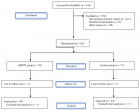Abstract
Case Report
Masquelet Technique for Reconstruction of a Fourth Metatarsal Defect Following a Low-velocity Gunshot Wound: A Case Report
Castagno C*, Campano D, Fernandez I and Weiss WM
Published: 02 November, 2023 | Volume 7 - Issue 1 | Pages: 022-026
The Masquelet technique has become increasingly popular in reconstruction scenarios such as osteomyelitis, cancer, and nonunions. The procedure is a two-staged approach: first, a polymethylmethacrylate (PMMA) cement spacer is inserted to fill a bone void. The spacer induces a membrane to form around it, and 6-9 weeks later, the second stage involves carefully extracting the spacer and filling the membrane with bone graft. Most of the current literature has published either femoral or tibial involvement for Masquelet studies, with limited published data on foot reconstruction. Here, the authors used the procedure for the fourth metatarsal. Despite complications, this case proves a more excellent utility and warrants further investigation into Masquelet techniques in the foot.
Read Full Article HTML DOI: 10.29328/journal.aceo.1001017 Cite this Article Read Full Article PDF
Keywords:
Masquelet; Induced-membrane; Pseudomembrane; Pseudosynovial membrane; Reconstruction; Fourth metatarsal; Gunshot wound; PMMA space
References
- Fowler KA, Dahlberg LL, Haileyesus T, Annest JL. Firearm injuries in the United States. Prev Med. 2015 Oct;79:5-14. doi: 10.1016/j.ypmed.2015.06.002. Epub 2015 Jun 24. PMID: 26116133; PMCID: PMC4700838.
- Cook A, Osler T, Hosmer D, Glance L, Rogers F, Gross B, Garcia-Filion P, Malhotra A. Gunshot wounds resulting in hospitalization in the United States: 2004-2013. Injury. 2017 Mar;48(3):621-627. doi: 10.1016/j.injury.2017.01.044. Epub 2017 Jan 30. PMID: 28173921..
- Bartlett CS, Helfet DL, Hausman MR, Strauss E. Ballistics and gunshot wounds: effects on musculoskeletal tissues. J Am Acad Orthop Surg. 2000 Jan-Feb;8(1):21-36. doi: 10.5435/00124635-200001000-00003. PMID: 10666650.
- Gouron R. Surgical technique and indications of the induced membrane procedure in children. Orthop Traumatol Surg Res. 2016 Feb;102(1 Suppl):S133-9. doi: 10.1016/j.otsr.2015.06.027. Epub 2016 Jan 7. PMID: 26774902.
- Stafford PR, Norris BL. Reamer-irrigator-aspirator bone graft and bi Masquelet technique for segmental bone defect nonunions: a review of 25 cases. Injury. 2010 Nov;41 Suppl 2:S72-7. doi: 10.1016/S0020-1383(10)70014-0. PMID: 21144933.
- Morris R, Hossain M, Evans A, Pallister I. Induced membrane technique for treating tibial defects gives mixed results. Bone Joint J. 2017 May;99-B(5):680-685. doi: 10.1302/0301-620X.99B5.BJJ-2016-0694.R2. PMID: 28455479.
- Abdellaoui H, Atarraf K, Chater L, Afifi MA. Congenital pseudarthrosis of the clavicle treated by Masquelet technique. BMJ Case Rep. 2017 Nov 8;2017:bcr2017221557. doi: 10.1136/bcr-2017-221557. PMID: 29122899; PMCID: PMC5695429.
- Calori GM, Mazza EL, Colombo A, Mazzola S, Colombo M. Treatment of an atrophic clavicle non-union with the chamber induction technique: a case report. Injury. 2017 Oct;48 Suppl 3:S71-S75. doi: 10.1016/S0020-1383(17)30662-9. PMID: 29025615.
- Morelli I, Drago L, George DA, Romanò D, Romanò CL. Managing large bone defects in children: a systematic review of the 'induced membrane technique'. J Pediatr Orthop B. 2018 Sep;27(5):443-455. doi: 10.1097/BPB.0000000000000456. PMID: 28368930.
- Konda SR, Gage M, Fisher N, Egol KA. Segmental Bone Defect Treated With the Induced Membrane Technique. J Orthop Trauma. 2017 Aug;31 Suppl 3:S21-S22. doi: 10.1097/BOT.0000000000000899. PMID: 28697078.
- Tong K, Zhong Z, Peng Y, Lin C, Cao S, Yang Y, Wang G. Masquelet technique versus Ilizarov bone transport for reconstruction of lower extremity bone defects following posttraumatic osteomyelitis. Injury. 2017 Jul;48(7):1616-1622. doi: 10.1016/j.injury.2017.03.042. Epub 2017 Apr 4. PMID: 28408083.
- Masquelet AC. Induced Membrane Technique: Pearls and Pitfalls. J Orthop Trauma. 2017 Oct;31 Suppl 5:S36-S38. doi: 10.1097/BOT.0000000000000979. PMID: 28938390.
- Makridis KG, Theocharakis S, Fragkakis EM, Giannoudis PV. Reconstruction of an extensive soft tissue and bone defect of the first metatarsal with the use of Masquelet technique: a case report. Foot Ankle Surg. 2014 Jun;20(2):e19-22. doi: 10.1016/j.fas.2013.11.006. Epub 2013 Dec 16. PMID: 24796840.
- Zoller SD, Cao LA, Smith RA, Sheppard W, Lord EL, Hamad CD, Ghodasra JH, Lee C, Jeffcoat D. Staged reconstruction of diaphyseal fractures with segmental defects: Surgical and patient-reported outcomes. Injury. 2017 Oct;48(10):2248-2252. doi: 10.1016/j.injury.2017.06.018. Epub 2017 Jun 23. PMID: 28712488.
- Liu F, Huang RK, Xie M, Pan H, Zhao JJ, Lei B. Use of Masquelet's technique for treating the first metatarsophalangeal joint in cases of gout combined with a massive bone defect. Foot Ankle Surg. 2018 Apr;24(2):159-163. doi: 10.1016/j.fas.2017.01.009. Epub 2017 Feb 17. PMID: 29409218.
- Pelissier P, Bollecker V, Martin D, Baudet J. Reconstruction du pied par la technique "bi-Masquelet" [Foot reconstruction with the "bi-Masquelet" procedure]. Ann Chir Plast Esthet. 2002 Aug;47(4):304-7. French. doi: 10.1016/s0294-1260(02)00123-1. PMID: 12420622.
- Largey A, Faline A, Hebrard W, Hamoui M, Canovas F. Management of massive traumatic compound defects of the foot. Orthop Traumatol Surg Res. 2009 Jun;95(4):301-4. doi: 10.1016/j.otsr.2009.02.005. Epub 2009 May 12. PMID: 19442599.
- Moghaddam A, Zietzschmann S, Bruckner T, Schmidmaier G. Treatment of atrophic tibia non-unions according to 'diamond concept': Results of one- and two-step treatment. Injury. 2015 Oct;46 Suppl 4:S39-50. doi: 10.1016/S0020-1383(15)30017-6. PMID: 26542865.
- Giannoudis PV, Faour O, Goff T, Kanakaris N, Dimitriou R. Masquelet technique for the treatment of bone defects: tips-tricks and future directions. Injury. 2011 Jun;42(6):591-8. doi: 10.1016/j.injury.2011.03.036. Epub 2011 May 4. PMID: 21543068.
- Micev AJ, Kalainov DM, Soneru AP. Masquelet technique for treatment of segmental bone loss in the upper extremity. J Hand Surg Am. 2015 Mar;40(3):593-8. doi: 10.1016/j.jhsa.2014.12.007. Epub 2015 Jan 31. PMID: 25648786.
- Apard T, Bigorre N, Cronier P, Duteille F, Bizot P, Massin P. Two-stage reconstruction of post-traumatic segmental tibia bone loss with nailing. Orthop Traumatol Surg Res. 2010 Sep;96(5):549-53. doi: 10.1016/j.otsr.2010.02.010. Epub 2010 Jun 4. PMID: 20605548.
- Flamans B, Pauchot J, Petite H, Blanchet N, Rochet S, Garbuio P, Tropet Y, Obert L. Pertes de substance osseuse à la main et au poignet traitées en urgence par technique de la membrane induite (technique de Masquelet) [Use of the induced membrane technique for the treatment of bone defects in the hand or wrist, in emergency]. Chir Main. 2010 Oct;29(5):307-14. French. doi: 10.1016/j.main.2010.06.008. Epub 2010 Jul 24. PMID: 20728395.
- Jiang N, Qin CH, Ma YF, Wang L, Yu B. Possibility of one-stage surgery to reconstruct bone defects using the modified Masquelet technique with degradable calcium sulfate as a cement spacer: A case report and hypothesis. Biomed Rep. 2016 Mar;4(3):374-378. doi: 10.3892/br.2016.584. Epub 2016 Jan 27. PMID: 26998279; PMCID: PMC4774369.
- Gaio N, Martino A, Toth Z, Watson JT, Nicolaou D, McBride-Gagyi S. Masquelet technique: The effect of altering implant material and topography on membrane matrix composition, mechanical and barrier properties in a rat defect model. J Biomech. 2018 Apr 27;72:53-62. doi: 10.1016/j.jbiomech.2018.02.026. Epub 2018 Feb 27. PMID: 29510858; PMCID: PMC5895482.
- Salgado CJ, Lin CH, Fuller DA, Duncan AN, Camison L, Mardini S. Foot salvage after loss of the first and second metatarsal rays with a free fibular osteocutaneous flap. J Am Podiatr Med Assoc. 2011 Nov-Dec;101(6):531-6. doi: 10.7547/1010531. PMID: 22106202.
Figures:

Figure 1

Figure 2

Figure 3

Figure 4

Figure 5
Similar Articles
-
Kummoona Chondro-Ossous Graft for Reconstruction of the Temporomandibular Joint in ChildrenRaja Kummoona*. Kummoona Chondro-Ossous Graft for Reconstruction of the Temporomandibular Joint in Children. . 2017 doi: 10.29328/journal.aceo.1001001; 1: 001-003
-
What is the future for Scapholunate interosseous ligament reconstruction?Amelia Carr,Saso Ivanovski,Randy Bindra,Cedryck Vaquette*. What is the future for Scapholunate interosseous ligament reconstruction?. . 2018 doi: 10.29328/journal.aceo.1001004; 2: 004-007
-
Masquelet Technique for Reconstruction of a Fourth Metatarsal Defect Following a Low-velocity Gunshot Wound: A Case ReportCastagno C*, Campano D, Fernandez I, Weiss WM. Masquelet Technique for Reconstruction of a Fourth Metatarsal Defect Following a Low-velocity Gunshot Wound: A Case Report. . 2023 doi: 10.29328/journal.aceo.1001017; 7: 022-026
Recently Viewed
-
Nasal cytology in patients with previous SARS-CoV-2 infection: occurrence of atypical lymphocytesArturo Armone Caruso*, Anna Miglietta, Giovanni De Rossi, Liliana Nappi, Veronica Viola, Stefano De Rossi, Salvatore Del Prete, Clara Imperatore, Sabato Leo, Daniele Naviglio, Monica Gallo, Daniela Marasco, Lucia Grumetto. Nasal cytology in patients with previous SARS-CoV-2 infection: occurrence of atypical lymphocytes. Adv Treat ENT Disord. 2023: doi: 10.29328/journal.ated.1001014; 7: 001-006
-
Nanoencapsulated Extracts from Leaves of Bauhinia forficata Link: In vitro Antioxidant, Toxicogenetic, and Hypoglycemic Activity Effects in Streptozotocin-induced Diabetic MiceBárbara Verônica Cardoso de Souza, Alessandra Braga Ribeiro*, Rita de Cássia Meneses Oliveira, Julianne Viana Freire Portela, Ana Amélia de Carvalho Melo Cavalcante, Esmeralda Maria Lustosa Barros, Luís Felipe Lima Matos, Tarsia Giabardo Alves, Maria. Nanoencapsulated Extracts from Leaves of Bauhinia forficata Link: In vitro Antioxidant, Toxicogenetic, and Hypoglycemic Activity Effects in Streptozotocin-induced Diabetic Mice. Arch Pharm Pharma Sci. 2024: doi: 10.29328/journal.apps.1001063; 8: 100-115
-
Oral Suspension as Versatile Galenic Formulation in PediatryMauro Luisetto*, Almukthar N, Edbey K, Mashori GR, Fiazza C, Dona’ l, Cabianca L, Latyshev O. Oral Suspension as Versatile Galenic Formulation in Pediatry. Arch Pharm Pharma Sci. 2024: doi: 10.29328/journal.apps.1001062; 8: 091-099
-
Scientific Analysis of Eucharistic Miracles: Importance of a Standardization in EvaluationKelly Kearse*,Frank Ligaj. Scientific Analysis of Eucharistic Miracles: Importance of a Standardization in Evaluation. J Forensic Sci Res. 2024: doi: 10.29328/journal.jfsr.1001068; 8: 078-088
-
The Synergistic Effect of Combined Linagliptin and Metformin Improves Hepatic Function in High-fat Diet/Streptozotocin-induced Diabetic RatsFolasade Omobolanle Ajao*,Ifedolapo Opeyemi Adeyeye,Noheem Olaoluwa Kalejaiye,Sodik Olasunkami Mukaila,Olalekan Samson Agboola,Marcus Olaoye Iyedupe. The Synergistic Effect of Combined Linagliptin and Metformin Improves Hepatic Function in High-fat Diet/Streptozotocin-induced Diabetic Rats. Ann Clin Gastroenterol Hepatol. 2025: doi: 10.29328/journal.acgh.1001050; 9: 004-012
Most Viewed
-
Feasibility study of magnetic sensing for detecting single-neuron action potentialsDenis Tonini,Kai Wu,Renata Saha,Jian-Ping Wang*. Feasibility study of magnetic sensing for detecting single-neuron action potentials. Ann Biomed Sci Eng. 2022 doi: 10.29328/journal.abse.1001018; 6: 019-029
-
Evaluation of In vitro and Ex vivo Models for Studying the Effectiveness of Vaginal Drug Systems in Controlling Microbe Infections: A Systematic ReviewMohammad Hossein Karami*, Majid Abdouss*, Mandana Karami. Evaluation of In vitro and Ex vivo Models for Studying the Effectiveness of Vaginal Drug Systems in Controlling Microbe Infections: A Systematic Review. Clin J Obstet Gynecol. 2023 doi: 10.29328/journal.cjog.1001151; 6: 201-215
-
Prospective Coronavirus Liver Effects: Available KnowledgeAvishek Mandal*. Prospective Coronavirus Liver Effects: Available Knowledge. Ann Clin Gastroenterol Hepatol. 2023 doi: 10.29328/journal.acgh.1001039; 7: 001-010
-
Causal Link between Human Blood Metabolites and Asthma: An Investigation Using Mendelian RandomizationYong-Qing Zhu, Xiao-Yan Meng, Jing-Hua Yang*. Causal Link between Human Blood Metabolites and Asthma: An Investigation Using Mendelian Randomization. Arch Asthma Allergy Immunol. 2023 doi: 10.29328/journal.aaai.1001032; 7: 012-022
-
An algorithm to safely manage oral food challenge in an office-based setting for children with multiple food allergiesNathalie Cottel,Aïcha Dieme,Véronique Orcel,Yannick Chantran,Mélisande Bourgoin-Heck,Jocelyne Just. An algorithm to safely manage oral food challenge in an office-based setting for children with multiple food allergies. Arch Asthma Allergy Immunol. 2021 doi: 10.29328/journal.aaai.1001027; 5: 030-037

HSPI: We're glad you're here. Please click "create a new Query" if you are a new visitor to our website and need further information from us.
If you are already a member of our network and need to keep track of any developments regarding a question you have already submitted, click "take me to my Query."
















































































































































